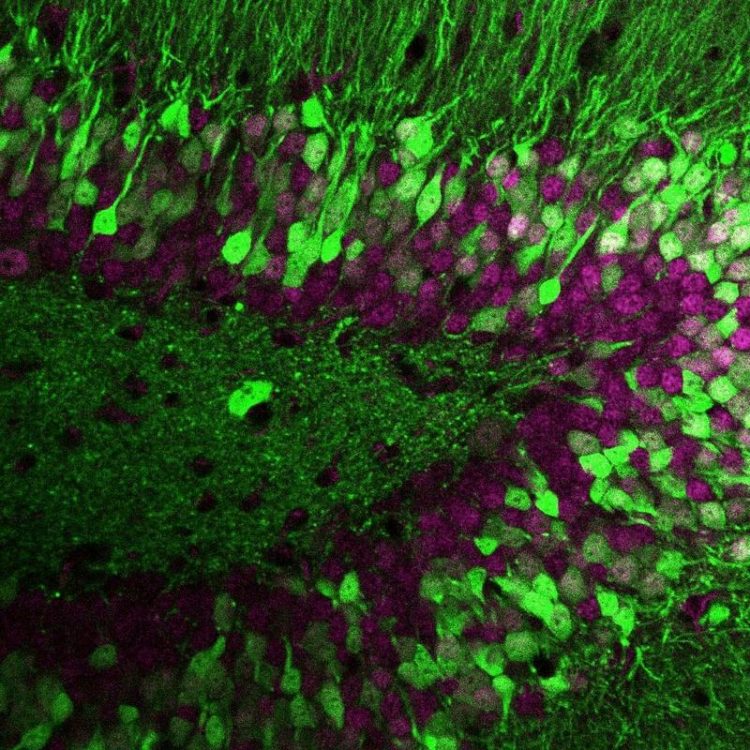Unique fingerprint: What makes nerve cells unmistakable?

Protein variants shape wiring of nerve cells in the brain. Biozentrum, University of Basel
Our brain consists of hundreds, if not thousands, of different types of nerve cells that control our brain functions due to their individual characteristics. But how do the different cell types manage to develop their diverse traits?
In a genome-wide analysis, the team led by Prof. Peter Scheiffele at the Biozentrum, University of Basel, has now discovered that alternative splicing leads to a broad range of variants of individual proteins, which ultimately allows to distinguish types of nerve cells.
Alternative splicing determines cell types
Alternative splicing can generate multiple different protein variants from a single gene. In the mouse model, Scheiffele's team investigated splice variants in a panel of neuronal cell types. “We have been able to identify hundreds of splice variants that enable us to differentiate between different types of neurons,” says Scheiffele. “There are unique repertoires of variants in each nerve cell type.”
These repertoires of splice variants significantly shape the identity and function of nerve cells. “Although all neuronal cell types contain the same set of genes, even closely-related cell types produce different splice variants,” explains Scheiffele.
In particular, proteins located at the neuronal contact points – the synapses, which mediate the transmission and processing of information – are extremely diverse. Thus, the splicing process also controls the function of the neuronal circuits in the brain.
Data platform for scientists
The generation and analysis of the extensive data sets is part of the EU-funded project “SPLICECODE”. In collaboration with the “Center for Scientific Computing” (sciCORE), a user-friendly website has been set up which allows scientists worldwide to investigate the role of individual splice variants in brain function.
Prof. Dr. Peter Scheiffele, University of Basel, Biozentrum, Tel. +41 61 207 21 94, Email: peter.scheiffele@unibas.ch
Heike Sacher, University of Basel, Biozentrum, Communications, Tel. +41 61 207 14 49, Email: heike.sacher@unibas.ch
Elisabetta Furlanis, Lisa Traunmüller, Geoffrey Fucile, Peter Scheiffele.
Landscape of ribosome-engaged transcript isoforms reveals extensive neuronal cell class-specific alternative splicing programs.
Nature Neuroscience (2019), doi: 10.1038/s41593-019-0465-5
Media Contact
More Information:
http://www.unibas.chAll latest news from the category: Life Sciences and Chemistry
Articles and reports from the Life Sciences and chemistry area deal with applied and basic research into modern biology, chemistry and human medicine.
Valuable information can be found on a range of life sciences fields including bacteriology, biochemistry, bionics, bioinformatics, biophysics, biotechnology, genetics, geobotany, human biology, marine biology, microbiology, molecular biology, cellular biology, zoology, bioinorganic chemistry, microchemistry and environmental chemistry.
Newest articles

High-energy-density aqueous battery based on halogen multi-electron transfer
Traditional non-aqueous lithium-ion batteries have a high energy density, but their safety is compromised due to the flammable organic electrolytes they utilize. Aqueous batteries use water as the solvent for…

First-ever combined heart pump and pig kidney transplant
…gives new hope to patient with terminal illness. Surgeons at NYU Langone Health performed the first-ever combined mechanical heart pump and gene-edited pig kidney transplant surgery in a 54-year-old woman…

Biophysics: Testing how well biomarkers work
LMU researchers have developed a method to determine how reliably target proteins can be labeled using super-resolution fluorescence microscopy. Modern microscopy techniques make it possible to examine the inner workings…





















